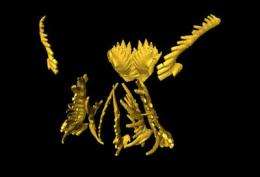The peculiar feeding mechanism of the first vertebrates

A fang-like tooth on double upper lips, spiny teeth on the tongue and a pulley-like mechanism to move the tongue backwards and forwards -- this bizarre bite belongs to a conodont and, thanks to fresh fossil finds, has now been analyzed and reconstructed by a research team headed by paleontologists from the University of Zurich. Their analysis sheds light on the origin of jaws. Their reconstruction shows for the first time how the first vertebrates fed.
Jaws made of bone are commonplace in the animal kingdom. However, how jaws developed in the course of evolution is still a mystery. Under the direction of paleontologist Nicolas Goudemand, a team of researchers from the University of Zurich and the European Synchrotron Radiation Facility set about solving this puzzle. Living and extinct jawless animals can yield clues as to the development of the jaw. The researchers studied fossilized conodonts – extinct, eel-shaped animals whose precise relationship with the actual vertebrates is still a matter of debate. For their project, which was funded by the Swiss National Science Foundation and just published in the American journal PNAS, the researchers analyzed new conodont fossils that date from around the biggest mass extinction event at the boundary between the Permian and Triassic periods.
Multitasking thanks to teeth on upper lips and tongue
In some of these new fossils discovered in China, the researchers noticed several conjoined tooth-like structures that occupied an unusual position in the mouth. Based on this discovery and the re-evaluation of other unusually constructed conodont feeding apparatus, the scientists developed a 3D animated model that shows how conodonts fed: most conodonts had to have two upper lips, upon each of which there was a long, fang-like structure. The conodonts also had a kind of tongue bearing a complex set of spiny or comb-like 'teeth'. The 'tongue' rested on pulley-like cartilage and could be moved backwards and forwards thanks to two opposing muscles. The conodonts used the 'tongue' and lips to grab food before two pairs of relatively robust, sometimes molar-like 'throat teeth' ground and cut it up.
Similarity with lampreys
The conodonts' unique feeding mechanism is fairly similar to that of the extant lamprey, which is widely regarded as the extinct conodonts' nearest relative. The new findings confirm that conodonts are to be considered primitive vertebrates from an evolutionary point of view. Moreover, due to the comparative feeding mechanism and other similarities, lampreys and conodonts must have a common ancestor which was one of the first vertebrates. This common ancestor must also have had a tongue mounted on pulley-like cartilage and therefore eaten in the same manner as the conodonts.
Provided by University of Zurich











1.jpg)






